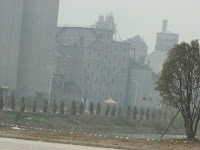Many of the hostels/hotels will buy train and bus tickets for you at a small fee so it is very convenient. It means you don't have to traipse across town and then get pushed around in the long queues.
From the bus window I snapped some photos of the houses that had interesting mosaic scenes on their balconies or front walls.

We also saw some long houses in the fields. They looked like they were made from rice straw or pressed earth covered with straw. It was difficult to tell if they were lived in, housed animals or were for some other use- my first thought was for growing mushrooms. We asked some locals but they had never seen them.

There were also many factories along the way and the air became more and more smoggy and the light a dull yellowish colour.
Nanjing has 5.29 million people. From 1368 - 1644 it was the nation's capital and it was the capital again of the Republic of China in the early 20th century.
There are many universities here and the hostel we are staying in has students from Australia studying here as well as teachers teaching in the local schools. It feels like a boarding house.
There is a gorgeous lake in the middle of the city but it was impossible to see across to the other side of it because of the pollution. People were out flying kites, riding bikes, dancing and we saw several pup tents along the shore. There was an American guy teaching English to any child who turned up. They were learning words like Easter bunny, jelly beans and basket!
Th city has a city wall from the Ming Dynasty (AD 1368-1644) it measures over 33kms- the longest city wall ever built in the world. It averages 12m high and 7m wide and was built from bricks from 5 provinces. Each brick was stamped with where it came from, the overseers name and rank as well as the brick maker's name. If the bricks broke they had to be replaced. Even back then they had quality control systems like they are introducing to the food industry today with its bar code labels that can identify the grower and his or her products!
In the 19th century, the Opium Wars brought the British to Nanjing and the first of the 'unequal treaties' was signed opening some Chinese ports to foreign trade and ceding Hong Kong to Britain.

In the 20th century, as the capital of the Republic of China it was the site of the worst war atrocity in Japan's assault on China. In 1937, as the occupation by Japan became imminent the Chinese government encouraged the people of Nanjing to stay saying: "All those who have blood and breath in them must feel that they wish to be broken as jade rather than remain whole as tile." Thousands of people were killed as they tried to flee through the tunnel to the only city gate that was not locked.

We visited the Sun Yat Sen Mausoleum along with thousands of others. He is recognized as the father of Modern China. There are hundreds of steps and gateways to go through before reaching the mausoleum. It is a well laid out area in a huge pine and osmanthus park and it would take a long time to see everything in the park.

We went by an electric shuttle cart to the Linggu Temple which was included in our ticket. The Buddhist temple is nearby a memorial hall to the monk Xuan Zang who brought back the Buddhist scriptures from India.

The plum blossoms looked great in the botanical garden and signs were everywhere advertising the 2008 International Blossom Festival.
